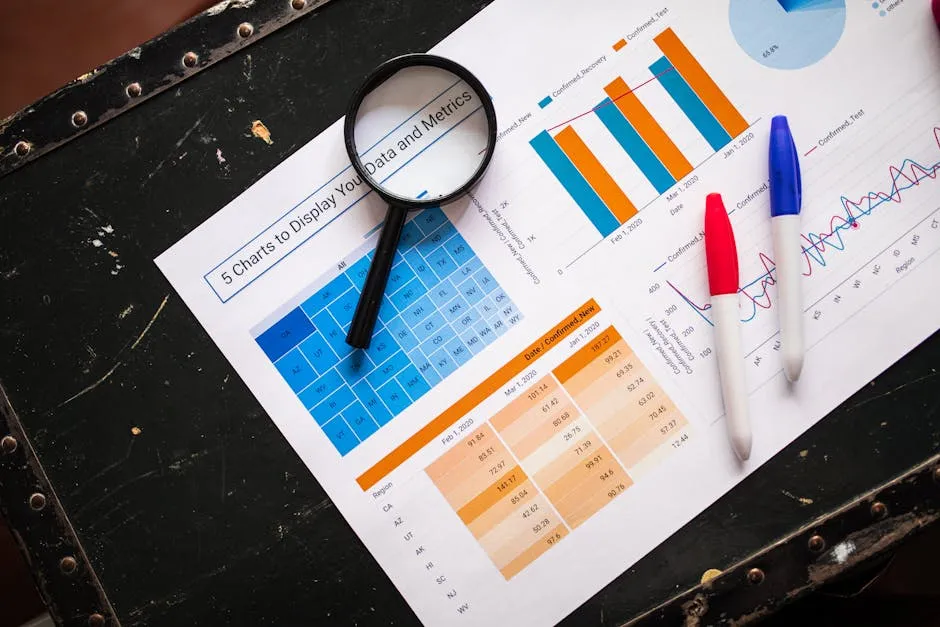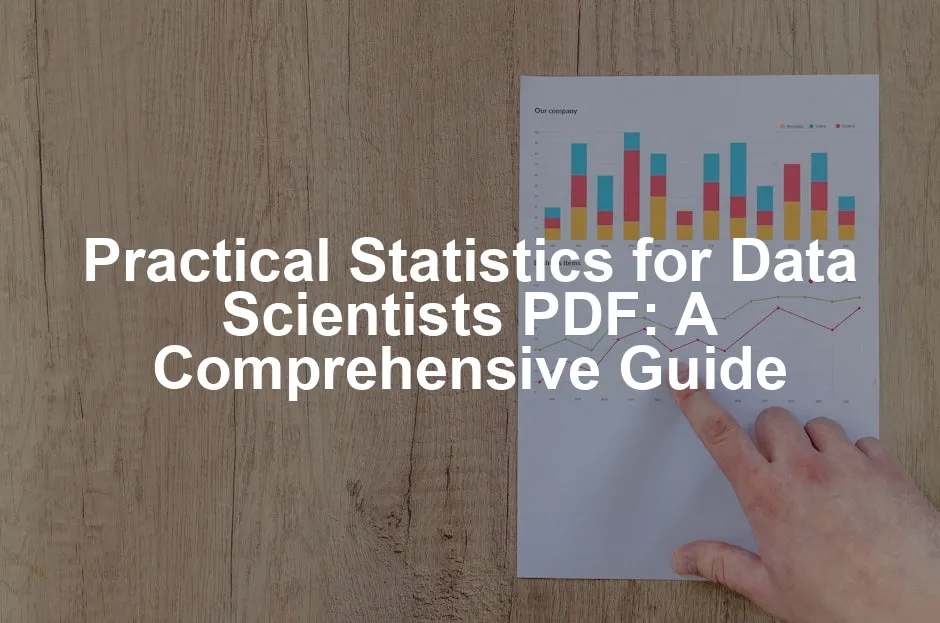Introduction
Statistics is the backbone of data science. Without it, your data analysis could be like trying to navigate a ship without a compass. The PDF “Practical Statistics for Data Scientists” is a must-have resource for anyone in the field. This guide bridges the gap between theory and practice. It arms data scientists with essential statistical knowledge, helping them make sense of the mountains of data they encounter daily.
The importance of statistics in data science cannot be overstated. It allows data professionals to extract meaningful insights from raw data. Understanding distributions, correlations, and variances can transform mere numbers into actionable strategies. This PDF focuses on practical applications rather than just theoretical knowledge. It provides real-world examples and tools to enhance your statistical prowess.
If you’re looking to dive deeper into the world of data analysis, consider grabbing a copy of Practical Statistics for Data Scientists: 50 Essential Concepts Using R and Python. This book is not just a read; it’s a game-changer that will arm you with the skills to tackle real-world data challenges.
In this article, we’ll explore the key concepts covered in the PDF. We’ll discuss practical applications of statistics in data science, including how you can incorporate these ideas into your work. Expect to learn about exploratory data analysis, regression techniques, and machine learning connections. By the end, you’ll see how this resource can elevate your data analysis game. Grab your favorite drink and let’s dive into the world of practical statistics!

For a deeper understanding of the statistical concepts, check out this resource on an introduction to statistical learning with python book length.
Understanding Practical Statistics
What is Practical Statistics?
Practical statistics is all about applying statistical methods to real-world data problems. Unlike traditional statistics that often emphasizes theories and formulas, practical statistics focuses on usability. It’s about making numbers work for you, not the other way around. Data scientists often find themselves knee-deep in data, and practical statistics equips them with the tools to make informed decisions.
This approach emphasizes real-life applications, ensuring that data scientists can effectively analyze datasets and derive valuable insights. For example, when faced with a dataset, a data scientist might use practical statistics to identify trends or anomalies that can inform business strategies. If you’re looking for more insights on this topic, I highly recommend Data Science for Dummies. This book simplifies complex concepts and is perfect for beginners.
Difference from Traditional Statistics
Traditional statistics often gets a bad rap for being dry and overly theoretical. While it has its place, it doesn’t always translate well to everyday data science work. Practical statistics, on the other hand, is geared towards application. It teaches you how to interpret results and make decisions based on data analysis.
In practical statistics, the focus is on understanding the context behind the numbers. You learn to ask the right questions and leverage data effectively. This shift in perspective is crucial for modern data scientists. With the growing importance of data-driven decision-making, practical statistics is your best friend. It provides the necessary skills to navigate through various datasets, making sense of complex information with ease.
Statistics in data science is not just about crunching numbers. It’s about storytelling with data. The insights drawn from statistical analysis can influence business decisions, improve customer experiences, and even drive innovation. Embracing practical statistics allows you to harness the true power of data, making you an invaluable asset to any team. For those looking to hone their skills further, consider reading The Data Science Handbook. It’s a comprehensive resource packed with insights!

Importance in Data Science
Data-Driven Decision Making: Statistics is the backbone of data-driven decision-making. It transforms raw data into actionable insights. With the right statistical tools, data scientists can identify trends, correlations, and variances. This analysis helps businesses make informed choices. Imagine running a retail store without knowing which products fly off the shelves! Statistics gives clarity in such situations. It empowers teams to optimize strategies, enhance customer experiences, and ultimately drive growth.
Connection to Machine Learning: Statistics and machine learning are like peanut butter and jelly. Statistical principles form the foundation for many machine learning algorithms. For instance, regression models help predict outcomes based on historical data. Classification algorithms rely on statistical tests to segregate data into categories. Understanding statistics allows data scientists to fine-tune algorithms. This synergy enhances the accuracy and efficiency of machine learning models. So, whether it’s predicting customer behavior or classifying emails, statistics plays a vital role.
For those diving into machine learning, the book Statistical Methods for Machine Learning is a fantastic resource that delves into the intricacies of these algorithms.

Overview of the PDF
Authors and Publication Details
Authors: The PDF features an impressive trio of authors. Peter Bruce, a veteran in the field, is the founder of the Institute for Statistics Education at Statistics.com. He has a wealth of experience in statistics and analytics. Andrew Bruce, a principal research scientist at Amazon, brings over 30 years of experience in statistics and data science. He knows the industry inside out. Finally, Peter Gedeck, a senior data scientist, specializes in machine learning algorithms. Together, they create a powerhouse of knowledge for data scientists.
Publication Details: The PDF, titled “Practical Statistics for Data Scientists: 50 Essential Concepts Using R and Python,” was published in May 2020 by O’Reilly Media. It spans 342 pages and has a file size of approximately 13.5 MB. The publication aims to provide a practical approach to statistics, making it accessible even for those with a basic understanding of R and Python. This resource is not just a book; it’s a toolkit for meaningful data analysis.

Content Summary
Key Concepts Covered: The “Practical Statistics for Data Scientists” PDF is packed with essential topics. It covers Exploratory Data Analysis, a critical step in understanding your data before any heavy lifting. Sampling Distributions help grasp how samples reflect a population. Statistical Experiments, including A/B testing, allow data scientists to make evidence-based decisions. Regression techniques estimate relationships between variables, while Classification methods categorize data points effectively. Lastly, it touches on Machine Learning, blending statistical principles with data-driven predictions.
Target Audience: This PDF is designed for data scientists who have a basic grasp of R and Python. If you can code in either language and are ready to level up, this resource is your go-to guide. It’s tailored for those who want to sharpen their statistical skills and apply them to real-world data challenges. So, whether you’re a budding data scientist or someone looking to brush up on your stats, this PDF has something for you! If you’re just getting started, consider the book Data Science for Beginners for foundational knowledge!

Key Statistical Concepts for Data Scientists
Exploratory Data Analysis (EDA)
Definition and Importance: Exploratory Data Analysis, or EDA, is like the first date with your data. You get to know it better before making any commitments. EDA helps uncover patterns, spot anomalies, and check assumptions. It’s crucial because it sets the stage for deeper analysis. Without EDA, you might miss out on significant insights lurking in those numbers.
Techniques: EDA employs several engaging techniques. Data visualization transforms bland numbers into eye-catching charts and graphs. Think of bar charts, histograms, and scatterplots—each tells a story. Summary statistics, like mean, median, and mode, provide a quick snapshot of your data’s central tendencies. They help you understand what’s typical and what’s not. And let’s not forget outlier detection! Identifying these anomalies can prevent you from drawing incorrect conclusions. After all, a data point isn’t just a number; it could be a sign of something interesting or a simple error.
Incorporating these techniques into your EDA workflow ensures you make informed and confident decisions as you progress in your data analysis journey. So, roll up those sleeves and get ready to dive deep into your datasets with EDA! If you need a solid reference, grab Data Visualization for Dummies to enhance your visual storytelling skills!

Sampling Distributions
Concept: Sampling distributions are the distributions of sample statistics. They allow data scientists to understand how sample means vary. Imagine trying to predict the average height of your class. If you only measure a few students, your average might be way off. Sampling distributions help us gauge the reliability of our estimates. They are crucial because they provide insight into the variability of sample statistics. This understanding informs decision-making based on sample data.
Central Limit Theorem: The Central Limit Theorem (CLT) is a cornerstone of statistics. It states that as the sample size increases, the distribution of the sample mean approaches a normal distribution, regardless of the population’s shape. This is significant because it means we can use normal probability techniques to make inferences about the population. For example, even if we sample from a skewed distribution, the average of our samples will be normally distributed if the sample size is large enough. This theorem empowers data scientists to make predictions and construct confidence intervals with confidence.

Statistical Experiments and Significance Testing
A/B Testing: A/B testing is a powerful method in data-driven decision-making. It compares two versions of a single variable to determine which performs better. For instance, an e-commerce site may test two different layouts to see which generates more sales. By randomly assigning users to either version, data scientists can evaluate performance metrics accurately. This method provides clear evidence of which option is more effective, making it invaluable for optimizing user experiences and increasing conversions. If you’re interested in mastering this technique, A/B Testing: The Most Powerful Way to Turn Clicks Into Customers is an essential read!
Hypothesis Testing: Hypothesis testing is fundamental in statistics. It involves making an assumption (the null hypothesis) and testing its validity. The alternative hypothesis represents what we want to prove. A p-value quantifies the evidence against the null hypothesis. A p-value below a predetermined threshold (like 0.05) indicates significant results. This means we have enough evidence to reject the null hypothesis. Understanding these concepts is essential for making sound conclusions from data, helping to avoid false positives and incorrect inferences.

For a comprehensive guide on hypothesis testing, check out this statistics hypothesis testing cheat sheet.
Regression Analysis
Types of Regression: Regression analysis helps understand relationships between variables. Linear regression predicts a continuous outcome based on one or more predictors. For example, predicting house prices based on square footage. Logistic regression, on the other hand, deals with binary outcomes, like determining whether a customer will buy a product. Both methods are crucial tools for data scientists to model and forecast trends accurately.
Applications: Regression analysis is widely applicable. It powers predictions in finance, healthcare, marketing, and more. For instance, a marketing team might use regression to forecast the impact of ad spend on sales. By analyzing historical data, they can estimate future performance. This predictive capability is invaluable for strategic planning and resource allocation, allowing businesses to make informed decisions based on trends and patterns. To further explore regression techniques, I recommend The Art of Statistics: Learning from Data.

Classification Techniques
Overview: Classification is like sorting socks—everyone loves a good pairing! In data science, classification involves predicting the category of a given data point. It’s crucial because it helps businesses make sense of their data. Whether it’s predicting customer churn or categorizing emails as spam, classification techniques turn raw data into actionable insights. This is the magic that transforms numbers into decisions.
Popular Methods: 1. Logistic Regression: Don’t let the name intimidate you! It’s a simple yet powerful method for binary outcomes. Think of it as a fancy coin flip. It predicts probabilities of classes using a logistic function. 2. Decision Trees: Picture a family tree, but instead of relatives, it shows decisions! This method splits data into branches based on feature values. It’s intuitive and easy to visualize, making it a favorite among data scientists. 3. Support Vector Machines (SVM): SVMs are like the superheroes of classification. They find the best boundary (or hyperplane) that separates different classes. They’re particularly effective in high-dimensional spaces, making them a go-to for complex datasets.

Machine Learning and Statistical Methods
Integration: In the data science kitchen, statistical methods are the secret ingredients for machine learning models. They provide the foundation for algorithms to learn from data. For example, regression analysis helps measure relationships between variables, while probability distributions guide predictions. The synergy between statistics and machine learning fuels data-driven innovations.
Examples: – Statistical Machine Learning Techniques: Techniques like Bayesian inference and regularization fall under this umbrella. Bayesian methods update beliefs based on new evidence, while regularization prevents overfitting. They help models generalize better to unseen data, ensuring reliable predictions. – Random Forests: This ensemble learning method combines multiple decision trees to improve accuracy. It reduces the risk of overfitting while maintaining interpretability. This magic blend of statistics and machine learning keeps model performance sharp. If you’re eager to explore this further, check out Data Science at the Command Line, which offers practical insights on integrating these concepts!

Practical Applications of Statistics in Data Science
Case Studies
Real-World Examples: Companies leverage statistical analysis to drive business decisions daily. For instance, Netflix uses customer segmentation to recommend shows based on viewing habits. A/B testing is another popular technique. Companies like Amazon use it to determine which webpage design increases sales. The beauty of statistical analysis is its ability to provide evidence-based insights that shape strategies.
Tools and Software: R, Python, and Excel are the heavyweights in practical statistics. R is beloved for its statistical packages, while Python offers flexibility with libraries like Pandas and Scikit-learn. Excel remains a staple for quick analyses and visualizations, making it accessible for beginners and seasoned analysts alike. If you’re looking to enhance your Python skills, I recommend Python for Data Analysis. It’s a great resource!

Challenges and Best Practices
Common Pitfalls: Statistical analysis isn’t without its challenges. Data scientists often misinterpret p-values, leading to incorrect conclusions. Another common mistake is neglecting data quality. Remember, garbage in equals garbage out. Poor data can derail even the strongest analysis!
Best Practices: To navigate these waters, always ensure data quality. Use robust statistical methods and validate findings through cross-validation. Document your process for transparency. Lastly, don’t forget to communicate your results clearly. Visualizations can turn complex data into digestible insights, making it easier for stakeholders to understand. If you’re keen on mastering this aspect, The Elements of Statistical Learning is an excellent guide to ensure you’re on the right path!

Conclusion
Summary of Key Points: Practical statistics are crucial for data scientists. They empower professionals to make informed decisions based on data analysis. Remember, the “Practical Statistics for Data Scientists” PDF is a treasure trove of essential concepts that can enhance your statistical skills. With real-world applications, this resource bridges the gap between theory and practice.
Call to Action: Don’t miss out on the opportunity to elevate your data science journey. Download the PDF today and start applying these invaluable statistical concepts to your projects. You’ll find yourself making smarter, data-driven decisions in no time!
Please let us know what you think about our content by leaving a comment down below!
Thank you for reading till here 🙂
All images from Pexels




